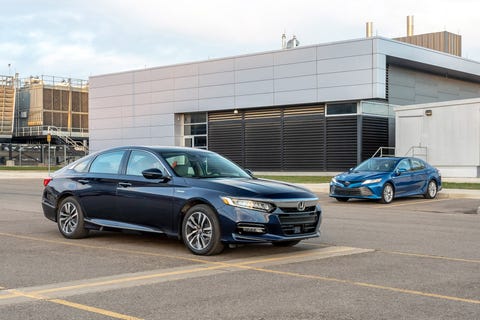
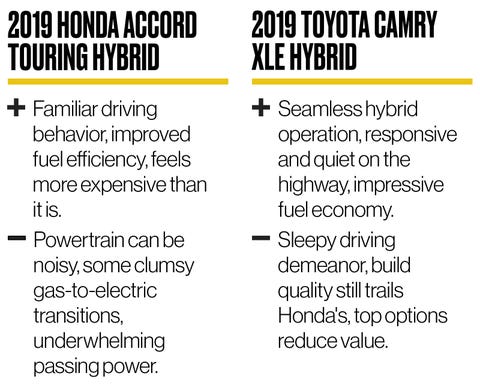
As demand for sedans declines due to consumers' infatuation with high-riding SUVs and pickup trucks, there are two cars that continue to crusade against the impending takeover. Sure, both the Honda Accord and Toyota Camry have seen sales wane over the past few years, but they still ranked among the top 10 best-selling vehicles of 2019. That's not a coincidence, because Honda and Toyota have earned a reputation for dependability and have developed a loyal customer base.
Likewise, the Accord and Camry recently entered an all-new generation together for the first time in their long-running rivalry. While we've compared them with other mid-size sedans, we haven't put their hybrid variants head to head—until now. And although the Accord's ongoing streak of 10Best awards seems like a spoiler alert, don't forget that the latest Camry is vastly improved, and the hybrid adaptation is arguably its best yet.
Face Off
There are no significant changes to the 2019 Honda Accord, and the hybrid that we drove for this review was the top-of-the-line Touring model loaded with standard leather upholstery, a head-up display, heated and ventilated power front seats, passive entry, wireless charging, a Wi-Fi hotspot, and all of the Accord's available driver-assistance tech (the Accord’s test results are from the test of a nearly identical 2018 model). While the cheapest 2019 Accord hybrid starts at $26,250—about $3100 less than the 2019 Camry LE hybrid—the photographed here stickered for $35,920.
The 2020 Toyota Camry adopts an all-wheel-drive option and a sport-tuned TRD variant, but those don't apply to the 2019 Camry XLE hybrid, which is the fanciest trim level available. The XLE has standard leather upholstery, heated power front seats, passive entry, wireless charging, and a suite of driver assists. Along with a base price of $33,930, our Toyota had $4570 worth of options, such as navigation, a head-up display, a premium audio system, and a sunroof. These extras helped close the equipment gap with the Honda, but our Camry still had less content and cost about $2500 more.
On the Road
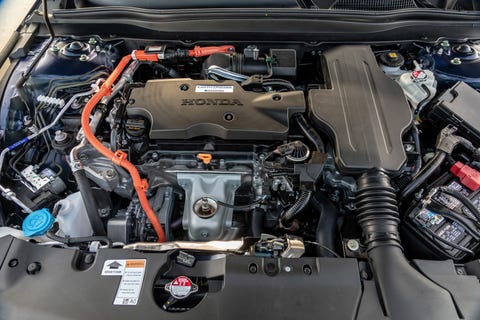
The Accord hybrid uses a 2.0-liter Atkinson-cycle inline-four and a motor-generator to drive the car, as well as a dedicated generator-starter to feed electricity to feed the drive motor. Combined output is 212 horsepower. Although its handoff between gas and electric power is sometimes less-than-smooth, the powertrain is responsive around town and when pulling away from stoplights. Acceleration at highway speeds, however, is a bit lazy and to top it off it is accompanied by a droning soundtrack. Still, it operates with much of the same athleticism and engagement that makes its nonhybrid counterparts so rewarding. Instead of crashing or floating over bumps, the Accord's suspension reduces them to slight hiccups. Its tactile steering is relaxed in feel but direct in action, with enough feedback for engaged drivers to appreciate twisty roads. Despite the uneven responses that often plague the brake pedals of hybridized vehicles, the Honda's is consistently firm and easy to modulate. Unfortunately, our Accord’s low-rolling-resistance rubber contributes to a lengthy 189 feet to stop from 70 mph, which was nine feet more than the Camry.
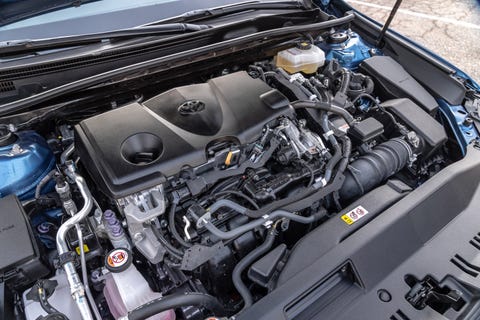
With Toyota's history of hybrid integration, we're not surprised that the Camry's powertrain felt more refined than the Accord's. Toyota's hybrid system consists a two-motor transaxle (one of the motor-generators delivers motive force) that pairs with a 2.5-liter Atkinson-cycle inline-four to produce a combined 208 horses. Unlike the Accord hybrid, the Camry's continuously variable automatic transmission also has a simulated manual mode that allows the driver to swap simulated gear ratios using steering-wheel-mounted paddle shifters. While the Toyota isn't as snappy when pulling away from a stop, it felt more powerful when passing on the highway and sounds quieter under load than the Honda. Its gas-electric transition is less intrusive as well. However, the Camry doesn't feel nearly as composed on the road as the Accord. Its steering is less predictable and lacks the responsiveness of the Honda's helm. Although we appreciated the Camry's quiet ride and forgiving suspension that gently lean the car around sharp corners, it doesn't isolate bumps as well as the Accord, and its brake pedal feels soft at the top of its travel, which makes it somewhat tricky to modulate in traffic.
Both hybrids boast better fuel-economy ratings than their gasoline counterparts, but only the Camry XLE model gets outshined by its own siblings. While the XLE has EPA estimates of 44/47 mpg city/highway, the less expensive LE hybrid is rated at 51/53 mpg. Every 2020 Accord hybrid has the same government ratings—48 mpg across the board—but the 2018 Touring hybrid that we tested, which is mechanically identical to the 2019 model, only managed 42 mpg on our 75-mph highway test, or 2 mpg shy of a 2018 Camry we tested.
Interior
The Accord has a sophisticated interior that defies its price tag. The attractive materials, precise controls, and smart design make it easy to enjoy inside. The digital gauge cluster looks slick and offers myriad menus, but both it and the 8.0-inch touchscreen atop the dash can wash out in direct sunlight. Still, the user-friendly infotainment system has large onscreen icons and physical buttons and knobs. The leather-wrapped steering wheel feels lovely to hold and hosts intuitively bundled controls for active-safety and audio system features. It's too bad that Honda's initially nonintuitive push-button shifter arrangement diminishes the Accord's mostly flawless ergonomics. Otherwise, front-seat passengers benefit from comfy seats, and those in the back can enjoy 2.8 inches of extra legroom compared with the Camry. The Accord hybrid's battery pack is mounted under its rear seat, so it doesn't affect the car's 17 cubic feet of trunk space, which is enough to swallow seven carry-on suitcase boxes; the Camry can accommodate only six.
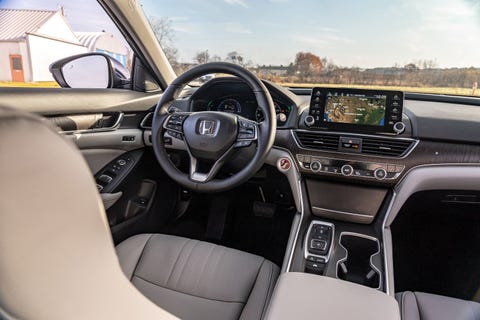
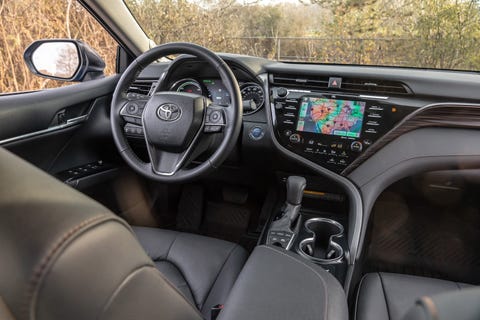
Conclusion
While sedans have become less popular, Honda and Toyota have recently reported increased hybrid sales. That makes sense with the crescendo of electric vehicles entering the market and these two brands' pedigrees in hybrid technology. Toyota may have built the best Camry yet, and the hybrid version exemplifies the breed with seamless operation and excellent fuel economy. However, it's not significantly more efficient than the Accord hybrid, and the Camry's greater refinement under its hood is offset by less sorted driving manners, as well as a smaller and less pleasant cabin. Factor in the stronger value of the Honda, and the Accord's hybrid variant, much like the rest of the Accord lineup, makes for a winning combination.
Specifications
2019 Honda Accord Hybrid Touring
VEHICLE TYPE
front-engine, front-wheel-drive, 5-passenger, 4-door sedan
PRICE AS TESTED
$35,920 (base price: $35,920)
POWERTRAIN
DOHC 16-valve 2.0-liter Atkinson-cycle inline-4, 143 hp, 129 lb-ft; permanent-magnet synchronous AC motor, 181 hp, 232 lb-ft; combined output, 212 hp; 1.1-kWh lithium-ion battery pack
TRANSMISSION
single-speed direct-drive
CHASSIS
Suspension (F/R): struts/multilink
Brakes (F/R): 12.3-in vented disc/11.1-in disc
Tires: Michelin Energy Saver A/S, 225/50R-17 94V M+S
DIMENSIONS
Wheelbase: 111.4 in
Length: 192.2 in
Width: 73.3 in
Height: 57.1 in
Passenger volume: 103 cu ft
Trunk volume: 17 cu ft
Curb weight: 3404 lb
C/D
TEST RESULTS*
Rollout, 1 ft: 0.4 sec
60 mph: 7.0 sec
100 mph: 20.3 sec
110 mph: 27.0 sec
Rolling start, 5–60 mph: 7.8 sec
Top gear, 30–50 mph: 3.9 sec
Top gear, 50–70 mph: 5.8 sec
¼-mile: 15.4 sec @ 90 mph
Top speed (governor limited): 115 mph
Braking, 70–0 mph: 189 ft
Roadholding, 300-ft-dia skidpad: 0.83 g
C/D
FUEL ECONOMY*
75-mph highway driving: 42 mpg
Highway range: 530 miles
EPA FUEL ECONOMY
Combined/city/highway: 48/48/48 mpg
2019 Toyota Camry XLE Hybrid
VEHICLE TYPE
front-engine, front-wheel-drive, 5-passenger, 4-door sedan
PRICE AS TESTED
$38,500 (base price: $33,930)
POWERTRAIN
DOHC 16-valve 2.5-liter Atkinson-cycle inline-4, 176 hp, 163 lb-ft; permanent-magnet synchronous AC motor, 118 hp, 149 lb-ft; combined output, 208 hp; 1.6-kWh nickel-metal-hydride battery pack
TRANSMISSION
continuously variable automatic
CHASSIS
Suspension (F/R): struts/multilink
Brakes (F/R): 12.0-in vented disc/11.1-in disc
Tires: Hankook Kinergy GT, 235/45R-18 94V M+S
DIMENSIONS
Wheelbase: 111.2 in
Length: 192.1 in
Width: 72.4 in
Height: 56.9 in
Passenger volume: 99 cu ft
Trunk volume: 15 cu ft
Curb weight: 3656 lb
C/D
TEST RESULTS*
Rollout, 1 ft: 0.3 sec
60 mph: 7.8 sec
100 mph: 19.2 sec
110 mph: 23.6 sec
Rolling start, 5–60 mph: 8.1 sec
Top gear, 30–50 mph: 3.7 sec
Top gear, 50–70 mph: 5.1 sec
¼-mile: 16.0 sec @ 91 mph
Top speed (governor limited): 116 mph
Braking, 70–0 mph: 180 ft
Roadholding, 300-ft-dia skidpad: 0.84 g
C/D
FUEL ECONOMY
75-mph highway driving: 44 mpg
Highway range: 580 miles
EPA FUEL ECONOMY
Combined/city/highway: 46/44/47 mpg
